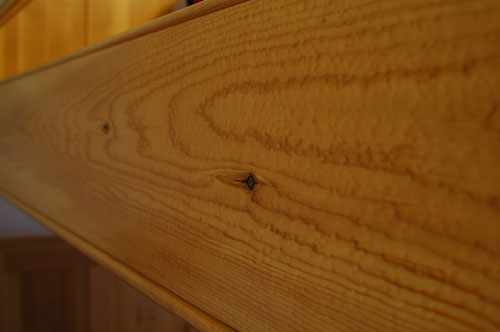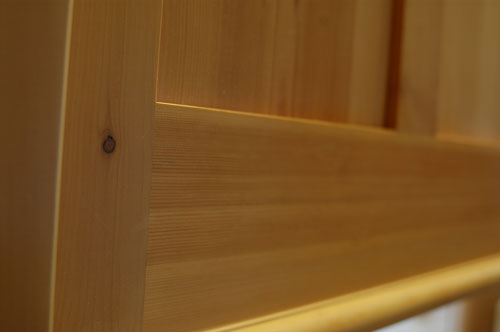Construction-grade lumber is the least expensive material for building fine woodworking projects and DIY trim, but even seasoned woodworkers are surprised to learn that the spruce, pine or fir planks destined for house frames is also ideal for building cabinets, trim and furniture. I know from more than 10 years experience using this wood that proper selection yields gorgeous planks at less than a dollar a board foot. Wood doesn’t get any cheaper than this, but you need to know what you’re looking for.
 Only a few kinds of construction-grade planks are worthy of fine woodworking. Find a supplier where you can select your own boards, then make your way to the stacks of 2x10s and 2x12s, twelve feet and longer. Even if you don’t need wood this long, big planks are always the straightest grained and most knot-free because they were cut from the largest and oldest trees. Don’t bother with anything smaller than 2×8.
Only a few kinds of construction-grade planks are worthy of fine woodworking. Find a supplier where you can select your own boards, then make your way to the stacks of 2x10s and 2x12s, twelve feet and longer. Even if you don’t need wood this long, big planks are always the straightest grained and most knot-free because they were cut from the largest and oldest trees. Don’t bother with anything smaller than 2×8.
First, seek construction-grade boards with the straightest grain and the least knots. It’s not unusual to find 16-foot long planks that are completely free of knots, and these are excellent. See my lumberyard video tour of the selection process.
As you claim boards for your own, understand that construction lumber comes in two types: very wet, green boards (marked S-GRN on the grade stamp) and kiln-dried (marked KD). When it comes to construction-grade lumber for fine woodworking, always choose kiln-dried stock. The reason is mold. Green construction lumber usually carries black stains because it’s shipped and stored sopping wet. Kiln dried construction lumber, on the other hand, is almost always bright and clean because its moisture content was brought down quickly by heat treatment after sawing, though it’s not quite dry enough for building furniture right away.
 Wood needs to have a moisture content of 7% to 9% to be stable for indoor projects in heated, Canadian homes, and kiln-dried construction-lumber will probably come in at 12% to 16%, depending on the season, your climate and the location the wood was stored in. This might not seem like a big difference, but it’s crucial. Build with wood that’s too wet and you’ll get parts that warp.
Wood needs to have a moisture content of 7% to 9% to be stable for indoor projects in heated, Canadian homes, and kiln-dried construction-lumber will probably come in at 12% to 16%, depending on the season, your climate and the location the wood was stored in. This might not seem like a big difference, but it’s crucial. Build with wood that’s too wet and you’ll get parts that warp.
Time is the key to drying lumber, but probably not as much time as you think. I’ve brought ice-covered 2x10s into my shop in February from an outdoor pile, then turned them into a stable, completed project five weeks later. The trick is to bring the wood into a heated environment, then promote air circulation around each piece with a fan between work sessions as they’re rough-cut, milled and joined together. It’s not unusual to see wood drop one percentage point per day when stored in a dry room with constant airflow. Even without a fan, you can expect wood to drop from 12% to 8% moisture content in a week. A moisture meter is the best way to eliminate the risk of building with wood that’s too wet. The money you save on your first construction-grade project will pay for this tool.
Although construction lumber is officially a softwood, it’s surprisingly hard. It also sands smoothly and takes finishes well. So much of Canada’s forests include the kind of spruce, pine and fir trees that are routinely turned into house frames, it’s a shame that we see almost none of it.
Our flag may feature the maple leaf, but maples grow on only the tiniest portion of our country. Spruce, pine and fir are really our indigenous woods, and they’re also the best kind of good deal going. You get a nice, low price, first-rate good looks, and a wood that’s as Canadian as it gets.